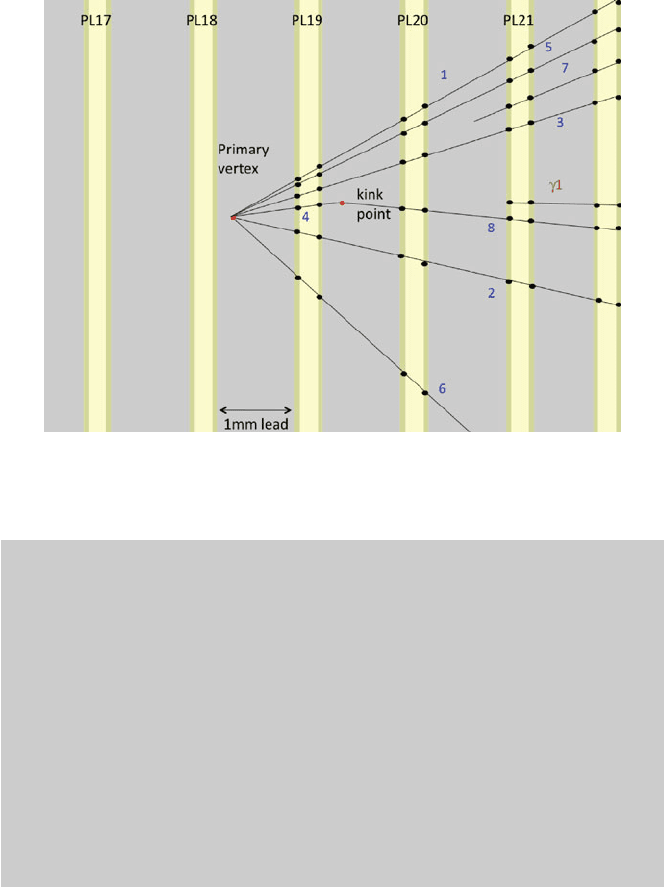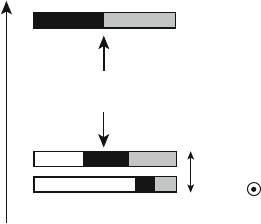Braibant S., Giacomelli G., Spurio M. Particles and Fundamental Interactions: An Introduction to Particle Physics
Подождите немного. Документ загружается.


12.9 Effects of Neutrino Oscillations 381
Fig. 12.16 Display of the OPERA
candidate event [12A10]. At the interaction (primary)
vertex, one has the reaction
C N !
C 5 charged tracks.The
(track 4) decays after
a 1 mm flight path, giving rise to a visible kink
(
!
C
). Hadrons can also be produced in
interactions. Hadrons
containing charmed quarks, for example, the
C
c
;D
C
, are an important
background source. The lifetime and the kinematics of the decay of these
particles are similar to those of
decay. However, the presence of a muon in
these hadronic events is a clear signature that a CC
interaction took place;
in this case, the event is not considered as a
candidate. Spectrometers
are needed to establish the presence and the electric charge of the muon: a
C
arises from the decay of a charmed particle, a
from the
decay.
Assuming m
2
23
D 2:5 10
3
eV
2
and sin
2
2
23
D 1,11 events are
expected within five years with an estimated background of 0.5 event. In
July of 2010, the OPERA Collaboration presented the first event candidate
of a
appearance in a
beam. Particle physics is constantly evolving (see
Fig. 12.16).
12.9 Effects of Neutrino Oscillations
The fact that neutrinos have mass, although small, is important and requires changes
in the Standard Model of the Microcosm. With three neutrino mass eigenstates,
1
;
2
;
3
, there are three mass differences m
2
ij
related by

382 12 CP-Violation and Particle Oscillations
m
2
23
C m
2
12
C m
2
31
D 0: (12.65)
Current measurements have identified two of the three mass differences: m
2
ˇ
in
the case of solar neutrinos (and KamLAND) (see Fig. 12.12), and m
2
atm
in the case
of atmospheric neutrinos (and K2K, MINOS), (see Fig. 12.15). The experiments
cannot indicate whether the two mass eigenstates which propagate from the Sun
(whose masses differ by m
2
ˇ
)areabove or below with respect to m
2
atm
(in
Fig. 12.17,theyareassumedtobebelow). The two possibilities are sometimes
referred to as normal hierarchy or inverted hierarchy. The ability to discriminate
between the two options could be solved with a beam of neutrinos from accelerators
passing through a large quantity of matter. In Fig. 12.17, the various neutrino flavor
content for each mass eigenstate are shown (jh
f
j
i
ij
2
DjU
fi
j
2
). For simplicity,
the figure ignores the small (and unknown) proportion of
e
in
3
.
The
e
fraction in
3
corresponds to jU
e3
j
2
DjU
13
j
2
D s
2
13
in the (12.51)matrix.
This quantity is currently only bounded by the data as jU
e3
j
2
< 0:032. A future
precision measurement of this quantity is crucial: in the U matrix (12.51), the phase
ı can be the origin for CP-violation in neutrino oscillations. This quantity enters in
the matrix U only combined with s
13
. The possible discovery of such violation is a
very hard task from the experimental point of view.
Since s
13
is small (
13
<10
ı
), the approximation of neutrino with a dominant
mass (Sect. 12.6.2) implies that the mixing angle measured with the disappearance
of atmospheric neutrinos
atm
corresponds to
23
D 45
ı
˙ 8
ı
, while that measured
with the disappearance of solar neutrinos
ˇ
'
12
D 34:5
ı
˙1:7
ı
.Theverylarge
values of
12
;
23
show that the mixing of leptons has a very different behavior from
that of quarks, where all mixing angles in the CKM matrix are small.
One of the most important quantities to be measured with precision is
13
,which
determines the fraction of
e
in
3
. An experiment able to measure this angle must
have L=E O.10
3
km/GeV), and must exploit
e
. Proposals were made for
(Mass)
2
Δm
2
atm
Δm
2
m
2
3
m
2
2
m
2
1
Fig. 12.17 Mass spectrum of the three neutrinos
1
;
2
;
3
(from bottom to top), assuming m
3
>
m
2
>m
1
. Since the weak interaction eigenstates
e
;
;
are a linear combination of mass
eigenstates, experiments can determine the
e
;
;
percentage in
1
;
2
;
3
. This percentage is
represented by shadings in the drawing. The
3
is 50%
(in black) e 50%
(gray). The
2
is
about 1/3
e
(white), 1/3
,1/3
. Finally, the
e
dominate in the
1
[P08]

12.9 Effects of Neutrino Oscillations 383
(anti)electron neutrinos from reactors, with L 1 km, and the study of possible
!
e
with L equal to hundreds of km (experiments Double Chooz, Reno,
Daya Bay). If
13
is not too small, the CP-violation in neutrinos could be studied
through the difference between P.
˛
!
ˇ
/ P.
˛
!
ˇ
/. This corresponds to
different oscillation behavior for neutrino and antineutrino beams. The experiment
would require a super intense (but conventional, Sect. 8.7) beam of neutrinos (and
antineutrinos).
The last remark is that neutrino oscillations are sensitive to the differences
between neutrino mass eigenstates, but not to the neutrino masses. With three
families and the hierarchy shown in Fig. 12.17 (or the reverse one), the mass of
the heaviest of the three mass eigenstates is equal to
p
m
2
atm
' 0:04 eV. In this
case, neutrinos which are so abundant in the Universe, have masses that play a
marginal role for the “missing mass” (see Chap. 13). However, it may well be that
the three neutrinos have average mass relatively higher, with small mass differences
between eigenstates. In this case, their mass would play an important role in the
Universe. Cosmology put an upper limit to neutrino masses, with a range depending
on assumptions of different cosmological models, that is,
X
i
m
i
< .0:17 2:0/eV: (12.66)
The asymmetry between baryons and antibaryons in the Universe could not
have developed without some CP-violation in the early stages of the Universe
evolution (which we describe in the next chapter). The only known source of
CP-violation (in the quark mixing) is not sufficient to explain the observations.
Thus, a CP-violation in the leptonic sector could be responsible for the observed
matter/antimatter asymmetry, and this makes the study of neutrino oscillations an
important connection between the microcosm and the macrocosm.

Chapter 13
Microcosm and Macrocosm
The “Standard Model” (SM) of the microcosm, the model of strong and electroweak
interactions, is a gauge theory in which the fundamental fermions are leptons and
quarks; it is based on the SU.3/
C
f
SU.2/
L
U.1/
Y
g
symmetry group. For en-
ergies below 100GeV, the
f
SU.2/
L
U.1/
Y
g
symmetry is spontaneously broken
through the Higgs mechanism, and the three weak vector bosons (W
C
;W
;Z
0
)
acquire mass. The mediators of the strong interaction (eight gluons) and that of the
electromagnetic interaction (the photon) remain massless.
The predictions of the SM have been verified with great precision, particularly
at LEP (see Chap. 9). The SM is an excellent description of the phenomena of the
microcosm (at least until
p
s ' a few hundred GeV), although an essential element
(the Higgs boson) remains to be discovered and studied.
There are many reasons, however, to believe that the SM is incomplete and
represents a valid theory at relatively low energies:
1. The SM has many free parameters not derived from the theory (the masses of
leptons, quarks and gauge bosons; the mass of the Higgs boson; the coupling
constants; :::).
2. The three family structure remains unexplained.
3. In the same family, there are two leptons and two quarks without any real
justification, even if this parallelism gives rise to the cancellation of divergences.
4. It does not contain gravity.
5. There are several unresolved “aesthetic” mathematics and physics problems. For
example, the electric charge of the fundamental fermions and bosons is quantized
in multiples of 1=3e, without a deeper justification.
6. There is the hierarchy problem. The scale of a possible unification with gravity
is the order of 10
19
GeV. One wonders why the masses of vector bosons (about
100 GeV) can be much smaller.
7. The matter-antimatter asymmetry observed in the Universe is not really justified
by the CP violation allowed within the SM.
For these reasons, more comprehensive models that contain the SM, in the low
energy limit, were sought. Some of these models consider quarks and leptons as
S. Braibant et al., Particles and Fundamental Interactions: An Introduction to Particle
Physics, Undergraduate Lecture Notes in Physics, DOI 10.1007/978-94-007-2464-8
13,
© Springer Science+Business Media B.V. 2012
385

386 13 Microcosm and Macrocosm
objects made of more elementary particles (composite models); in some models,
the Higgs and the W
˙
;Z
0
bosons are also regarded as composite; other models
are based on more complete symmetries, for example, the supersymmetry,or
attempting a true unification of electroweak and strong interactions in terms of a
single symmetry group (Grand Unified Theories, GUTs). Finally, some models are
even trying to include gravity (supergravity, SUGRA). In the following, we will be
briefly discuss, in a simplified and qualitative way, some of these models.
The natural energy scale in most models (supersymmetry, composite models) is
the TeV, while it is much higher in others (10
15
GeV for GUTs and 10
19
GeV
for Supergravity). There may also be intermediate scales of the order of 10
10
eV.
Research related to supersymmetric particles refer to the TeV scale, which are
accessible with the LHC. Energies associated with the GUT theories cannot be
reached with accelerators on Earth. Therefore, “relic” particles produced in the early
moments of the Universe (e.g., magnetic monopoles) as well as rare phenomena
such as proton decay should be searched for.
In the past, some connections between the microcosm and macrocosm have
been highlighted, though only recently were such connections understood and was
their importance fully appreciated. In general, our increasing knowledge of the
submicroscopic phenomena allows us to better understand the early Universe, even
if sometimes the opposite occurred. The most important connection is that needed to
understand what happened in the early Universe, just after the Big Bang. When the
Universe was very small, it could be considered as a hot gas of highly energetic
particles. As the Universe expanded (in four dimensions), it cooled down (the
average energy of its constituents decreased) and it passed through several phase
transitions where the nature of the particles involved in the “gas of the Universe”
varied [W08].
Unified theories of fundamental interactions have been developed in the context
of particle physics, and then applied to describe the evolution of the Universe
after the Big Bang. For subnuclear physicists, the first moments of the Universe
represent the equivalent of a limitless energy accelerator! Collisions at LEP have
reproduced situations that were typical, some 10
10
–10
9
s after the Big Bang,
while the collisions studied at the LHC (
p
s D 14 TeV) correspond to typical
situations of about 10
12
–10
11
s after the Big Bang.
13.1 The Grand Unification
As mentioned in point (3) of the introduction, in a single fermion family of the
Standard Model, there are two quarks and two leptons. We may think that quarks
and leptons are different manifestations of a single particle. This would suggest
that there is a connection between the strong force acting between quarks and the
electroweak interaction between leptons and between quarks. Quarks and leptons
can be member of a multiplet; amongst the members of the multiplet, in addition

13.1 The Grand Unification 387
50
60
40
30
20
10
10
5
10
2
10
4
GeV
10
10
10
15
μ [GeV]
0
α
i
_
1
(μ)
10
16 GeV
Minimal
Supersymmetric
Model
50
60
40
30
20
10
10
5
10
10
10
15
μ [GeV]
0
α
i
–1
(μ)
Standard Model
α
2
–1
α
2
–1
α
3
–1
α
3
–1
α
1
–1
α
1
–1
ab
Fig. 13.1 Energy dependence of the inverse of the coupling constants g; g
0
;g
S
.D ˛
1
;˛
2
;˛
3
/ up
to 100 GeV and their extrapolation to the energy of 10
15
GeV: (a) according to the simplest model
and (b) including the supersymmetry in the form of the Minimal SuperSymmetric Model (MSSM)
to the strong and weak interaction between quarks, to the weak interaction between
leptons, a new interaction between a quark and a lepton should exist. In this way,
we can think of a real unification of the fundamental forces, the electroweak and the
strong (only gravity would be left out).
Another indication in favor of Grand Unified Theories arises from the evolution
with energy of the inverse of the three coupling constants g D e= sin
w
;g
0
D
e= cos
w
;g
S
D
p
4˛
S
(see Fig. 13.1a). When energy increases, the three
constants start to converge and if the dependence with respect to the energy does
not change, they should reach an almost equal value at the enormous energy of
about 10
15
GeV [13D94,13L94].
1
To incorporate quarks and leptons in one family, the symmetry group should
be enlarged. This group contains the known fundamental particles and explains
the Grand Unification; below 10
15
GeV, it must give rise to the symmetries of the
Standard Model through spontaneous symmetry breaking; therefore, one must have,
for example,
SU.5/
10
15
GeV
! SU.3/
C
SU.2/
L
U.1/
Y
10
2
GeV
! SU.3/
C
U.1/
EM
: (13.1)
The special group of unitary symmetry SU.5/ is the simplest GUT symmetry group;
it is symmetric for rotations in a five-dimensions inner space. The spontaneous
breakings in (13.1) explain how a single unified force at very high energies
spontaneously breaks in the strong and electroweak interactions at 10
15
GeV first,
and then in the three known interactions at 10
2
GeV. To explain the symmetry
breaking at 10
15
GeV, a mechanism similar to the Higgs mechanism should be
introduced. New (and still undiscovered) vector bosons are needed.
Quarks and leptons of the first family are naturally contained in the symmetry
group SU.5/. The group SU.5/ has a representation containing a five-dimensions
1
This extrapolation over 13 orders of magnitude is probably pure speculation.

388 13 Microcosm and Macrocosm
Fig. 13.2 Z
0
coupling
through a
fermion–antifermion loop
Z
0
f
f
-
γ
multiplet and a 5 5 matrix. The five-dimensions multiplet is of the type R, i.e.,
with right-handed particles. The 5 5 matrix is antisymmetric, thus with only ten
independent particles of type L, i.e., left-handed:
5
R
D
0
B
B
B
B
B
@
d
r
d
b
d
g
e
C
e
1
C
C
C
C
C
A
R
.5 5/
L
D
0
B
B
B
B
B
@
0
u
g
u
b
u
r
d
r
0 u
r
u
b
d
b
0 u
g
d
g
0e
C
0
1
C
C
C
C
C
A
L
: (13.2a)
The indices r; b; g indicate the colors (r D red, b D blue, g D green). Other
multiplets refer to the antiparticles of the multiplets (13.2a) and are of the type
5
L
D
0
B
B
B
B
B
@
d
r
d
b
d
g
e
e
1
C
C
C
C
C
A
L
.5 5/
R
D
0
B
B
B
B
B
@
0 u
g
u
b
u
r
d
r
0 u
r
u
b
d
b
0 u
g
d
g
0e
0
1
C
C
C
C
C
A
L
: (13.2b)
Quark fractional charge. The total charge of each particle multiplet must be equal
to zero, that is, Q.d
r
C d
b
C d
g
C e
C
C
e
/ D .1=3 1=3 1=3 C 1 C 0/ D
0, and similarly for the determinant of the matrix (13.2a, b) on the right. This
implies that the charge of quarks must be a fraction of that of the leptons and
that the proton charge must be equal and opposite in sign to the electron charge,
Q
p
DQ
e
.
Doublets .
e
;e
/
L
;.u;d
0
/
L
. GUT theories explain the classification of leptons
and quarks in doublets, for example, .
e
;e/
L
, .u;d
0
/
L
, and explain the relations
between electric charges, such as, Q./ Q.e/ D Q.u/ Q.d /.
Prediction for sin
2
w
. The diagram of Fig. 13.2 shows the mixing of the Z
0
boson
with the photon through a fermion–antifermion loop. It may be considered as a
mixing similar to the K
0
K
0
mixing introduced in Sect. 12.2.

13.1 The Grand Unification 389
The coupling of the Z
0
to the f f pair is I
3
Q sin
2
w
(11.75a); the coupling
of the to the f
f pair is Q; for the GUT 5 representation, we have (antiquark L
states have I
3
D 0)
Particles I
3
Q
0
B
B
B
B
B
@
d
r
d
b
d
g
e
e
1
C
C
C
C
C
A
L
0
0
0
1=2
C1=2
C1=3
C1=3
C1=3
1
0
:
The sum of the couplings for the five members of the multiplet is
˙
5
Q.I
3
Q sin
2
w
/ D 0: (13.3a)
Since Z
0
; are orthonormal states, hZ
0
jiD0,andEq.13.3a gives
sin
2
w
D
˙QI
3
˙Q
2
D
3
8
: (13.3b)
This is larger compared to the measured value at
p
s D 91 GeV (sin
2
w
' 0:23),
but it refers to the GUT unification energy scale, 10
15
GeV. If the corrections
shown in Fig. 13.1 are applied to the coupling constants g; g
0
, one has sin
2
w
.
p
s D
91 GeV/ ' 0:21, which is in better agreement with the measured value.
13.1.1 Proton Decay
The gauge bosons generate transitions between the members of a multiplet.
Considering, for instance, the quintet
5 in (13.2b): gluons generate transitions
between quarks; the W
˙
bosons generate transitions between e
and
e
(and
between quarks of different flavor). In SU(5), massive bosons (denoted X; Y )
must exist. They generate transitions between quarks and leptons, violating both
the baryonic and the leptonic number conservation. The proton decays through
diagrams like that illustrated in Fig. 13.3, with the exchange of massive X; Y bosons
(m
X;Y
10
15
GeV).
The experimental results obtained with large underground water Cherenkov
detectors containing thousands of tons of water or with sampling calorimeters with
about 1,000 tons of iron, showed that the average proton lifetime is very long, that is,
p
.p !
0
e
C
/>8:2 10
33
years. Calculations based on SU(5) diagrams like that
of Fig. 13.3 predict a lower lifetime, 10
30
years. Despite its beauty, it seems that

390 13 Microcosm and Macrocosm
p
e
+
u
uu
u
d
X
π
0
a
b
Y
u
u
d
e
+
u
u
p
π
0
p
u
u
π
0
d
d
p
dd
π
0
u
u
e
+
d
e
+
d
Y
X
Fig. 13.3 Illustrative diagrams of proton decay, p ! e
C
0
in GUT theories, by exchanging
(a)anX boson (with electric charge C4=3)and(b)aY boson (with charge C1=3)ofSU(5)
the simplest GUT model based on SU(5) should be rejected. There are indeed other
models based on more complex groups, for example, SO(10), which have more
parameters and provide longer lifetimes. The combination of the supersymmetry
with GUT allows one to consider the p ! K
C
decay as the most probable. This
leads to a longer proton lifetime, about 10
33
year (the current experimental limit
[P10] is
p
>6:7 10
32
year).
13.1.2 Magnetic Monopoles
GUT theories require the existence of supermassive magnetic monopoles (MMs).
They could be created as point-like topological defects at the time of the Grand
Unification symmetry breaking into subgroups (one of which is the U(1)
Y
group)
at 10
15
GeV (13.1). These MM should have a mass m
M
equal to the mass of the
massive X; Y bosons, divided by the unified coupling constant ˛ at 10
15
GeV:
m
M
'
m
X
˛
10
15
0:03
3 10
16
GeV: (13.4)
The MM magnetic charge g is predicted by the Dirac relation
egD n „c (13.5)
where n is an integer. If we take as the elementary electric charge that of the electron
and n D 1,wehaveg D 68:5e in the symmetric unit system of Gauss. The magnetic
charge g is therefore huge. The introduction of MMs in the Maxwell equations
produce a complete symmetry between electric and magnetic fields; the symmetry is
“numerically broken” by the value of magnetic charge, much larger than the electric
one, and by the incredibly large mass of MMs, m
M
10
17
GeV.

13.1 The Grand Unification 391
The MM production mechanism and their current abundance in the Universe
is an additional problem. MMs with masses so large cannot be produced by any
accelerator, present or predictable, even in the distant future. They could only be
produced in the early Universe, in the phase transition when the GUT symmetry
group breaks into subgroups containing U(1). The MMs would be produced as
almost point-like topological defects. Their number in the Universe depends on the
number of causally disconnected regions. In cosmological models without inflation
(see Sect. 13.6), the number is high; if the Universe went through an inflationary
phase, the number of regions not causally related would be small and the number of
MMs would be very low. Another production mechanism is through high energy
particle collisions immediately after the phase transition, for example, through
e
C
e
! M M . This mechanism may persist for a limited time period after the
phase transition because the average energy per particle decreased quickly over
time.
Thus far, all magnetic monopole searches give negative results [13G84].
13.1.3 Cosmology. First Moment of the Universe
As mentioned in the case of magnetic monopoles, the basic ideas of Grand Unified
Theories influenced the cosmology of the first instants of the Universe. The model
for the point-like origin of the Universe (the Big Bang) predicts that the huge
initial temperature decreased as the Universe expanded. Electroweak and strong
interactions were unified from 10
44
to 10
35
s, when the Universe was in a
high symmetry state. As the temperature decreased, phase transitions occurred.
This happens, for instance, for a magnetic substance: at a high temperature, there is
no preferred direction; when the temperature decreases below the Curie point, the
material loses the rotational symmetry. Magnetic domains appear: this corresponds
to a more ordered phase, but with a lower degree of symmetry. Something similar
happened (see Sect. 13.6)attD10
35
s, corresponding to a temperature of 10
15
GeV
.'10
28
K). In this (almost certainly exothermic) phase transition, many important
events occurred in the Universe evolution: an exponential expansion; the production
of magnetic monopoles and other particles; the decay of the X and Y bosons, and
the origin of the baryon asymmetry.
Let us briefly analyze this last point. GUT theories provide processes with
violation of the baryon and lepton numbers. A small CP violation is also foreseen:
the X; Y bosons decay, producing a number of particles slightly larger than the
number of antiparticles. With the successive particle-antiparticle annihilation, the
small particle excess (small in percentage, but large in number) will produce
the present Universe made of matter and no antimatter, and with a baryon-to-
photon ratio equal to D n
B
=n
' 10
9
–10
10
. The photons are mainly the
photons of the cosmic microwave background (CMB) radiation that fills the entire
Universe. Today, the CMB has a temperature of 2.7 K, corresponding to 10
4
eV.
While the number of photons is much larger than that of the baryons, the mass
